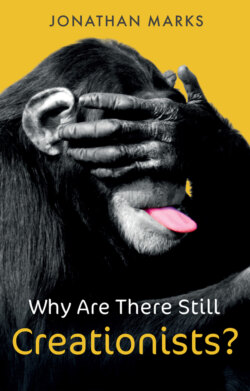Читать книгу Why Are There Still Creationists? - Jonathan Marks - Страница 10
Ancestry and Relatedness
ОглавлениеThere is a broad intellectual frame available to us to help make sense of the vigor and longevity of the rejection of evolution. That frame is kinship, the sense people make of their place in a social and moral world by conceptualizing their descent and relatedness to others. This is a particularly human thing to do, as the apes do not (as far as we can tell) have relationships homologous to spouse, in-law, father, grandma – much less kissing cousin, baby daddy, heir, adopted child, step-child, or remote ancestor. These relationships are what structure the course of our lives; for a notable example, in Game of Thrones Jon Snow is reminded continually that he is Ned Stark’s bastard son (before tragically falling in love with his aunt).
In case of human evolution, though, the passion is focused on whether our ancestors were apes. The ancestors, as noted earlier, are always sacred, in the broad anthropological sense of “special.” If you think the apes in our ancestry aren’t special, try denying them to a biologist. Benjamin Disraeli made the options clear in 1864: “Is man an ape or an angel? My lord, I am on the side of the angels. I repudiate with indignation and abhorrence the contrary view, which is, I believe, foreign to the conscience of humanity.”
Of course as a prominent Jew-turned-Anglican, Disraeli was particularly sensitive to the presumption that our descent is a primary determinant of who and what we are. (Indeed, a few decades later, Franz Kafka would use the ape-turned-human as a metaphor for the assimilated European Jew in his story “Report to an Academy.”) Disraeli wanted us not to be descended from apes, so that we may be angels. He articulated this crude but widespread ultimatum only a few years after the publication of The Origin of Species, when the idea of ape ancestry was still fresh. But why this idea should necessarily preclude our siding with the angels is unclear. Certainly Disraeli himself did not become Earl of Beaconsfield on account of his ancestry, but, if anything, in spite of it.
Our similarity to the anthropoids was in fact already well known. An old Roman poet named Quintus Ennius observed how similar we are to the monkey, the most horrid of beasts (“Simia quam similis turpissima bestia nobis”), a saying preserved by Cicero and repeated in the foundational scientific works of Francis Bacon and Carl Linnaeus. Disraeli could hardly deny the similarity of human and ape, but what vexed him was its meaning – a question that had indeed long vexed scholars. What is the meaning of a creature who matches us physically bone for bone, muscle for muscle, organ for organ, and yet is not human? That, in fact, had been the question initially posed by the anatomist Edward Tyson back in 1699. Knowing that walking and talking served to distinguish us from the animals, Tyson was fascinated by a creature recently brought back from Africa. Its position could readily be established by its lack of language, which was intimately connected to thought, morality, and spirit. This creature – which we now know to have been a chimpanzee – lacked the power of speech, and thereby lacked the connection to God that all humans have.
On the other hand, there did not seem to be any obvious anatomical reason (for the state of knowledge in 1699) why the creature should not be able to walk like us. Its body corresponded eerily to our own, and yet Tyson had not actually seen the creature walk. Rather, it used the knuckles of its hands to bear its weight. That must have been, reasoned Tyson, because it was mortally ill (which it was), so Tyson compromised and had the creature drawn standing up, with the aid of a cane. The chimpanzee was thus anatomically continuous with people, but intellectually (and presumably spiritually) a gulf away.
This anatomical proximity between human and ape became increasingly familiar over the course of the eighteenth century, but remained difficult to explain. By the mid-1700s, the naturalist Count de Buffon had recognized that the most obvious meaning of this similarity, indeed of patterns of physical similarity in the animal kingdom generally, was that it signified a trail of descent. But once you saw it like that, where would such a trail end?
After all, Buffon reasoned, if you argued that the donkey is built so much like a horse that it should be considered part of a horse “family,” and is thus some sort of transformed primordial horse, then two things followed. First, you could say exactly the same thing about human and ape; and second, you couldn’t stop there, because you could make precisely the same argument for equids and hominids being transformed variations of a mammalian “family,” or mammals and birds being transformed variations of a vertebrate “family.” The only clear stopping point would be the origin of life itself. By the same argument that God made a primordial feline, from which lions, ocelots, and panthers are all descended, one could argue just as readily that God made a primordial mammal, from which lions, ocelots, panthers, bears, giraffes, monkeys, and beavers are all descended; or a primordial vertebrate, from which lions, ocelots, panthers, bears, giraffes, monkeys, beavers, eagles, frogs, and tunas are all descended. This was a scary intellectual place – in which all life might be genealogically related by virtue of common descent, as indicated by their nested patterns of anatomical correspondence – and Buffon retreated from it. A century later, Darwin eventually proved him right.
